Custodians of vendor partner programmes do not have it easy today. Refresh and realign too fast and partners will fail to get returns from their investments. Refresh too slow and risk becoming a follower in the market. Executives from Epicor, Liferay, Mindware, OPSWAT and SolarWinds share their perspectives on how manage this cocktail of variables, leveraging cross selling, bundling, rebates and incentives.
The constant updates in electronic communications channels via digital technologies and digital workplace tools have transformed and elevated partner communication by providing real-time communication between partners and vendors, enabling teams to work together seamlessly regardless of their physical location.
Vendors must provide assets and resources to partners on an ongoing basis, keeping them informed about trends, market insights and best practices, allowing them to differentiate themselves in the market, attracting new customers, and driving incremental revenue growth.
Partner programmes are equipped with training and certifications that are founded on latest technology trends of cloud computing, cybersecurity, artificial intelligence, machine learning, for specific partners who may need it.

Impact of digital transformation
ERP, for example is a foundational element of successful digital transformation journey as these platforms centralise data, optimise processes, and offer real-time insights. With digital transformation programmes having made significant advancements, the focus has been on intelligent automation and insights.
With modules such as Enterprise Content Management, Manufacturing Execution Systems, AI, ML, and business intelligence evolving around the core enterprise, ERP platforms are playing a pivotal role in enabling automation and business insights.
“Recognising this, we have adapted our partner programme to include specialisation tracks, providing education, enablement, commercial incentives for achieving certification. This enables partners to deliver the complete transformation journey for their customers,” says Paul Flannery, VP Channel Sales, International Region, Epicor.
“Digital transformation has enhanced vendor partner programmes through improved data analytics, enabling real-time performance tracking and more informed decision-making. Automation boosts efficiency, reducing manual tasks, allowing focus on strategic goals,” remarks Toni Azzi, Vice President Africa, Qatar and Levant, Mindware.
Most vendors are adapting latest technologies, mainly digital platforms, into their partner programmes. Digital platforms expand partner programme reach and scalability, facilitating global partnerships. They also allow for customisation, providing support and content to meet specific partner needs.
Digital transformation uses modern digital technologies, including all types of public, private, and hybrid cloud platforms, to create and modify a company’s business process, culture, and customer experiences. There is no doubt it has played a significant role in the evolution of vendor partner programmes and partner business models.
“Vendors are required to understand both the evolving technologies and how to include cloud platforms in their partner programme ecosystem,” says Alessandro Porro, VP Global Channels, OPSWAT.



Cross selling
Bundling and cross-selling of vendor assets benefits all stakeholders. From the perspective of the vendor and the partner, this represents a greater deal size, but from the perspective of the customer, it yields a more comprehensive solution, which can work better to complete their digital transformation journey.
“This approach is as relevant in the software world as it was for hardware, especially when vendors have designed their platforms with a modular approach,” says Epicor’s Flannery.
Independent modules, which can be seamlessly integrated together, are perfect for bundling. These extend and augment the capabilities of the solution, the customer is already purchasing, and makes the job of cross-selling much easier. Ultimately, it is a win-win for everyone.
“Bundling and cross selling of software and services are no different from hardware selling. Usually, channel partners are able to upsell additional software and services that complement project deployment for the customer,” says Brendan Binedell, Regional Sales Manager, Liferay Middle East.
“Vendors can then reward partners promoting these transformational technologies with attractive incentives in the same way as it is applicable to hardware selling. Reselling partners such as integrators, are typically motivated to focus on digital transformation trends through incentive packages,” adds Binedell.
Cross-selling services works when additional complementary software or services are added to enhance existing solutions with options like collaborative tools or advanced security. Subscription models encourage comprehensive service tiers or features through subscription-based pricing.
“In today’s channel world, where the focus has shifted towards software and services, the concepts of bundling and cross-selling have adapted to meet new customer needs and business models. These strategies are applied through a number of ways including solution-oriented bundling, delivering integrated packages addressing multiple business needs encompassing hardware, software, and services,” says Mindware’s Azzi.
Customisation and flexibility, are offered through customisable bundles that meet specific business requirements. Ecosystem integration focuses on products that enhance ecosystem compatibility and interoperability; and value-added services include training and support to maximise software investment and customer satisfaction.
“By adapting bundling and cross-selling strategies to software and services, companies can enhance offerings, meet diverse customer needs, and generate additional revenue streams, while fostering stronger customer relationships,” adds Azzi.
The concept of bundling and cross-selling is, and has been absolutely applicable to the software and services world. Particularly, if a partner is offering solutions that are part of a platform and, or that require some handholding in order to be fully optimised.
In fact, it is common for customers, end-users to invest in a particular subset of solutions within a platform, and later in time expand their investment into other areas of need. “Landing and expanding by means of bundling and cross-selling is a path to embed a partner as the customer’s trusted advisor,” says OPSWAT’s Porro.
“Software sales are getting more and more complicated. Add to that, the many ways for customers to transact with the partner ecosystem via resellers, MSPs, CSPs, and GSIs. What we are seeing more and more is multi-partner engagement during an end-user engagement. The partner that resells or transacts the sale may not be the partner that is providing professional services,” says Anna Wilkins, VP Global Sales Execution, SolarWinds.


Rebates and incentives
As Epicor pivoted from an on-premises to a cloud world, its channel programme has evolved to enable partners to participate in that journey in a way that supports the significant changes in P&L, cash flow, working capital, and margins in that move to an annuity-based business model. Fundamental to this are the rebates and incentives Epicor offers that improves their margin when they successfully secure larger deals.
In today’s channel ecosystem, where software and services dominate, traditional incentives have evolved to drive partner engagement and sales growth effectively.
“At Liferay, our incentive programme is designed to support this shift. Partners are rewarded based on their tier, Silver, Gold, and Platinum, with benefits extending to new business, ongoing managed services, and project sizes,” says Liferay’s Binedell.
According to Mindware’s Azzi, traditional volume rebates and incentives have evolved to fit new business models in today’s channel world of software and services.
These now take the form of usage-based incentives where rewards are linked to the volume of service used or the number of active users or tiered pricing models where incentives increase with higher subscription levels, encouraging premium commitments. Incentives increase with deeper specialisation in specific technologies such as security, automation, artificial intelligence.
“What we also see is performance metrics extending beyond sales featuring incentives that are based on certifications, resources, customer acquisition, customer retention, and other metrics. Flexible rebate structures stand out for its feature of flexibility with credits for future purchases or additional services,” says Azzi.
Cross-selling and up-selling incentives encourage expanding the project scope or integrating complementary hardware, software or services. This adaptation ensures incentives align with long-term engagement and the recurring revenue models prevalent in software and services.
The concept of volume rebates and incentives is equally applicable to software and services.
“I am not a big believer in so-called automatic rebates. Rather, I am a big believer in strategic, focused rebate programmes that drives partner behaviour and partner success, based on specific indicators that we see from end-users,” says OPSWAT’s Porro.
“We recently launched our enhancements to the Transform partner programme at our Global Summits, February in Lisbon, March in Bali, and April in Miami. As a part of our BIG 3 Acceleration Programme, we launched an incentive to support performance and volume. The more our partners book, and the earlier they book, the more of a rebate they receive,” says SolarWinds’ Wilkins.


Programme refreshes
There has to be a balance of consistency, for partners to invest in understanding the potential returns, while evolving the programme in a timely manner, side by side.
“Epicor assesses its model at least once or twice per year, adding additional products, features and incentives to the programme to enable partners to continue to grow sustainably and profitably into the future,” says Epicor’s Flannery.
Regular reassessment ensures that elements such as dashboards, registration processes, and approval systems stay current with industry trends and technological shifts. “With the rapid pace of technological advancement, vendor partner programmes should be updated and realigned to remain effective,” says Liferay’s Binedell.
A proactive approach helps partners adapt quickly, capitalise on emerging opportunities, and align more closely with evolving business objectives and technological landscapes.
“Given the swift pace of technology evolution, vendor partner programmes should be frequently reviewed and realigned to stay effective and relevant to the targeted markets,” adds Mindware’s Azzi.
When timing updates, there are certain areas that need consideration. These include technology lifecycles where programmes may need to be updated annually or biannually in fast-evolving sectors like software and cybersecurity.
Programmes need to be adjusted more frequently if market demand, customer preferences, or competitive landscapes shift rapidly. The use of regular analyses of performance data and partner feedback needs to be taken into consideration when making necessary adjustments. There are also regulatory requirements. Vendors need to ensure compliance with new laws by updating programmes accordingly.
“Reviewing programmes at least once a year with potential for interim adjustments ensures they remain relevant and supportive of partners’ needs,” continues Azzi.
OPSWAT’s Porro, advises that mature partner programmes should contain structural elements that foster continuous and sustainable growth, yet are sufficiently nimble and flexible to introduce partner acceleration elements as technology and specific customer demands evolve.
“Our point of view at SolarWinds is that partner programmes should be updated typically once a year, possibly twice, depending on shifting market conditions, growth in the market, partner capabilities, and analysis of incentives impact,” summarizes SolarWinds’ Wilkins.

Key takeaways: Adapting modern day partner programmes
Partner programme refreshes
- There has to be a balance of consistency for partners to invest, while evolving the programme in a timely manner: Paul Flannery, Epicor
- Epicor assesses its model at least once or twice per year, adding additional products, features, incentives to enable partners to grow profitably: Paul Flannery, Epicor
- With the rapid pace of technological advancement, vendor partner programmes should be frequently updated and realigned: Brendan Binedell, Liferay Middle East
- Given the pace of technology evolution, vendor partner programmes should be reviewed and realigned to stay effective: Toni Azzi, Mindware
- Reviewing programmes at least once a year ensures they remain relevant and supportive of partner needs: Toni Azzi, Mindware
- Mature partner programmes should contain elements that foster continuous growth, yet are nimble enough to introduce partner acceleration as technology and customer demands evolve: Alessandro Porro, OPSWAT
- Vendors are required to understand both evolving technologies and how to include cloud platforms in their partner programme ecosystem: Alessandro Porro, OPSWAT
- Partner programmes should be updated once a year, possibly twice, depending on shifting market conditions, growth in the market, partner capabilities, and analysis of incentives impact: Anna Wilkins, SolarWinds
Cross selling and bundling
- This approach is as relevant in the software world as it was for hardware alone, especially when vendors have designed their platforms with a modular approach: Paul Flannery, Epicor
- Bundling and cross selling of software and services are no different from hardware selling: Brendan Binedell, Liferay Middle East
- Channel partners are able to upsell additional software and services that complement project deployment: Brendan Binedell, Liferay Middle East
- Vendors can reward partners promoting transformational technologies with incentives in the same way as it is applicable to hardware selling: Brendan Binedell, Liferay Middle East
- Reselling partners such as integrators, are typically motivated to focus on digital transformation trends through incentive packages: Brendan Binedell, Liferay Middle East
- In today’s channel world, where the focus has shifted towards software and services, the concepts of bundling and cross-selling have adapted to meet new business models: Toni Azzi, Mindware
- Strategies are applied through a number of ways including solution-oriented bundling, delivering integrated packages addressing multiple business needs encompassing hardware, software, and services: Toni Azzi, Mindware
- Landing and expanding by means of bundling and cross-selling is a path to embed a partner as the customer’s trusted advisor: Alessandro Porro, OPSWAT
- Software sales are getting more complicated. Add to that the many ways for customers to transact via resellers, MSPs, CSPs, and GSI: Anna Wilkins, SolarWinds
- What we are seeing is multi-partner engagement during an end-user engagement. The partner that transacts the sale may not be the partner that is providing professional services: Anna Wilkins, SolarWinds
Rebates and incentives
- Partners are rewarded based on their tier, with benefits extending to new business, ongoing managed services, and project sizes: Brendan Binedell, Liferay Middle East
- What we also see is performance metrics extending beyond sales featuring incentives that are based on certifications, resources, customer acquisition, customer retention: Toni Azzi, Mindware
- Flexible rebate structures stand out for its flexibility with credits for future purchases or additional services: Toni Azzi, Mindware
- I am not a big believer in so-called automatic rebates. I am a big believer in strategic, focused rebate programmes that drive partner behaviour and success: Alessandro Porro, OPSWAT
- The more our partners book, and earlier they book, the more of a rebate they receive: Anna Wilkins, SolarWinds




